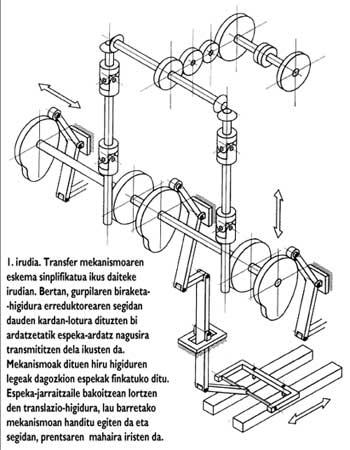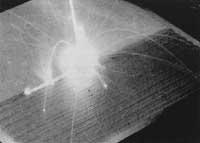MH: simulation status and capabilities
1996/12/01 Azkoaga, Joseba | Ugarte, Agustin | Urzelai, Gurutz Iturria: Elhuyar aldizkaria
Knowing its behavior before building the machine, the manufacturer can know whether or not its machine meets the needs of its customers, and modifying the mathematical model will study its design. When the model response is adequate, a machine prototype is built. This prototype and the final product are not very different and usually it is enough to make small tweaks in the prototype. This, on the one hand, saves the manufacturer many high cost prototypes and, on the other hand, helps to reduce the design time of the product. Another simulation application is the fault detection in operating machines. This can reduce the high costs of long machine stops, as the failure is previously known.
Traditional simulation tools
Currently MATLAB and MATRIX are one of the best known software and are based on block diagrams. These tools are very well adapted tools for the simulation of numerical controls, motors and regulators, since their block base is in signal processing and control theory. However, these block diagrams are not very suitable for the construction of mathematical models that describe the dynamic behavior of mechanical and/or hydraulic systems, since this means writing the equations manually before placing them in blocks. Therefore, these are usually performed using Laplace transfer functions.
These Laplace transfer functions describe only the behavior of the entire machine and do not provide any information about each component. On the other hand, the value of the parameters of these transfer functions is practically impossible to know before building the machine.
However, currently the market is demanding global or mechatronic designs that optimize the entire system, that is, that allow to know the behavior of all components, both electric, mechanical or hydraulic, during the operation of the machine, and optimize all components of the working conditions.
Achieving these global designs requires new simple system-wide simulation tools, created specifically for mechatronic simulations.
New simulation tools
The best-known simulation tools are those based on Bond Graph. Bond Graph is a technique for the development of models based on the energy exchange of systems. The advantage of these methods in the development of mechatronic models and global designs lies in the graphic representation of models, the use of models of physical components and the use of a common language for any field.
On the other hand, the Bond Graph can be easily joined with block diagrams. If the Bond Graph model of the system is built, the program automatically generates the differential equations that will be used to perform the simulation of the system, these being parametric. Given its characteristics, we can affirm that the Bond Graph is at a level of physical and non-mathematical modeling.
Practical application
In milling machines, especially on the main axis, the large masses must move at higher and higher speeds and as a flexible system in the cart vibrations and position errors appear to the detriment of manufacturing tolerances. Therefore, when developing new designs you can see the utility and convenience of the model.
Practical application comparing the simulation of the main axis model of a large milling machine in which IDEKO is located with the measured data. Simplified diagram of the milling machine shaft.
It is an electro-mechanical system formed by the milling shaft, the control, the position and speed regulator, the AC motor, the reducer formed by belt and two pulleys, the screw/nut, the axial bearing, the operators, the bed and two supports.
The control provides position slogans, these position slogans are converted by regulators into voltages and applied to motor. Consequently, the motor generates an electric current that produces a mechanical moment. The mechanical moment is applied to the nut using a reducer consisting of straps/poles. The nut rotates and moves at once. This rotation is possible thanks to the axial bearing on it. The outer ring of the bearing is attached to the carriage and moves with it. The reaction generated by the axial displacement of the nut is collected by the screw, the brackets and the bed.
The mechanical model has considered the variable axial flexibility of the screw, the flexibility and friction of the belts, bearings, nuts and supports (guides, screw nut performance and friction moment), as well as all the masses. The electrical model has been made in the usual way, that is, in block diagrams.
In this case, we have simulated the usual routes, the cosine route and the position path obtained by means of a speed trapezium slogan.
Conclusions
There are currently development methods and simulation methods that enable mechatronic products for machine tools “well and first”. The indicated milling machine simulations show the strength of the Bond Graph development method in this type of system.
With IKERLAN, machine tool manufacturers can adopt the following simulation methods, thanks to the European project OLMECO, promoted by the European Union, and the project “Simulation of Mechatronic Systems in Machine Tool”, co-financed by CICYT and the Basque Government.

Gai honi buruzko eduki gehiago
Elhuyarrek garatutako teknologia





